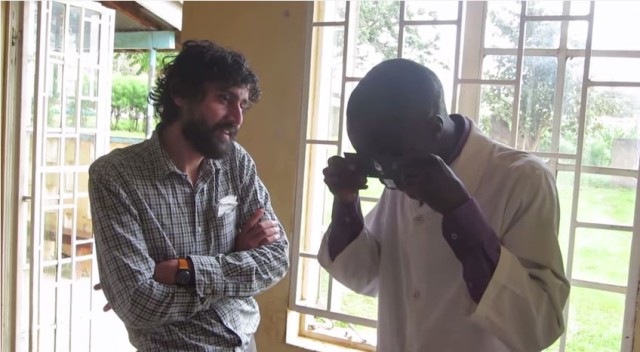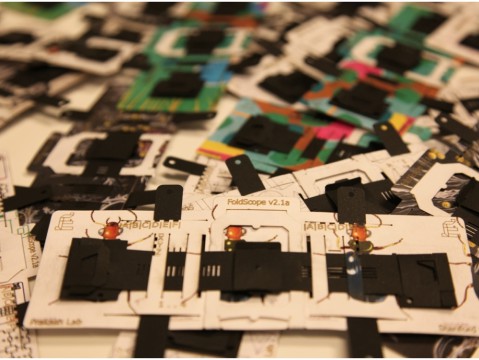Manu Prakash, a bioengineer at Stanford University, has designed an inexpensive, origami microscope to allow people from around the world to explore, make discoveries and answer questions like these. The microscopes are made out of waterproof paper, assembled by the end-user, lightweight, small enough to fit in your pocket and cost less than $1 to produce. Prakash calls them Foldscopes, and they were born out of a desire to make scientific tools accessible to all.
 Manu Prakash shows health care workers in developing countries how to use his Foldscope.
Manu Prakash shows health care workers in developing countries how to use his Foldscope.
In designing the Foldscope, Prakash wanted to create an instrument that could be used both by healthcare workers in developing countries and remote areas, as well as by people who might not otherwise get the opportunity to look at the microscopic world. Foldscopes are currently in trials to be approved as diagnostic tools for diseases like malaria and African sleeping sickness. And, through the Ten Thousand Microscope project, Prakash has shipped approximately 50,000 Foldscopes to students and lifelong learners in more than 130 countries who submitted ideas for experiments or questions that they would like to answer using the Foldscopes.
 10K Microscopes: experiment to crowd-source a biology microscopy manual
10K Microscopes: experiment to crowd-source a biology microscopy manual
Many recipients are already reporting their findings on Prakash’s website. He hopes that this will create a network of learners asking questions, sharing experiments and getting inspired by science.
At the basic level, the Foldscope requires no external power or light source; you simply insert a sample slide into the Foldscope, hold it up to a light source and look through the tiny, salt grain-size lens. However, the Foldscope can be modified. For example, Prakash’s team has added external watch batteries, lights, filters and different lenses to make different versions of the Foldscope. You can even attach a smartphone to the microscope in order to record images. He hopes that children, hackers and tinkerers around the world will add to the Foldscope and explore new modes of microscopy.
More Resources
ARTICLE: Exploring with Microscopes (Science Learning)
This article provides an overview of how microscopes can be used and includes links to examples of how scientists are using microscopes in their work.
VIDEO: Science Spotlight:Bending Light with a New Kind of Microscope? (KQED QUEST)
Learn how microscopes work by using lenses to bend light to magnify objects.
ARTICLE: Smartphone Microscope Lens that Costs Just Pennies to Make (gizmag)
Researchers at University of Houston have created cheap lenses that attach to your smartphone to turn it into a microscope.
ARTICLE: 50 Things to Look at Under a Microscope (Examiner.com)
Here are 50 ideas for things you could look at under a microscope.
ARTICLE: Microscope Slide Making Ideas (Home Science Tools)
This article provides tips on making slides and ideas for various objects to view underneath a microscope.

